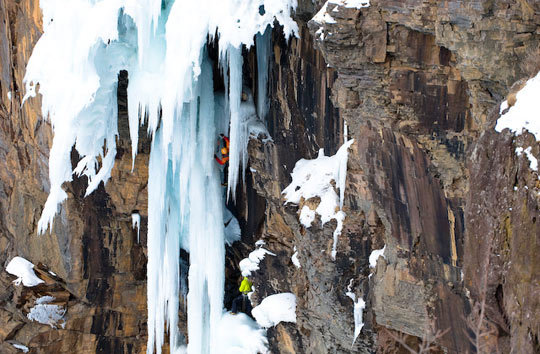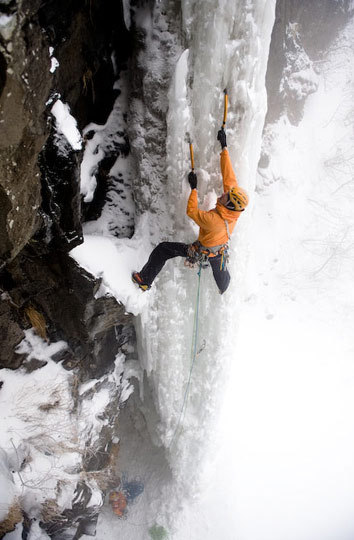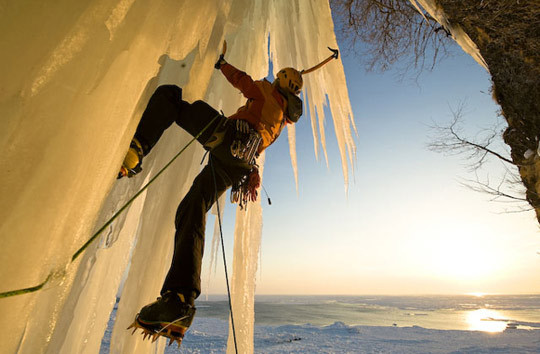
Albert Leichtfried about to enter the crux of Lector (WI7, 3 pitches, 80m), a new ice climb at Chiyoshibetu, Hokkaido, Japan. Leichtfried and Markus Bendler climbed in Hokkaido for more than two weeks in February and March 2008, accompanied by photographer Hermann Erber. [Photo] Hermann Erber
Albert Leichtfried and Markus Bendler have made the first ascent of Lector (WI7, 3 pitches, 80m) at Chiyoshibetu, Hokkaido, Japan, during an exploratory ice climbing trip together with photographer Hermann Erber. Initially the trio was intrigued by Hokkaido’s reputation as a powder skier’s paradise. Banking on the cold temperatures and plentiful precipitation that the Japanese Alps are known for, they went in search of quality ice climbing—a difficult proposition in a foreign land with no information or guidebook.

Bendler seeking solace on Runzee III (WI5), Raiden, Japan. [Photo] Hermann Erber
Leichtfried knew he and his partners would need local help before arriving for their fifteen-day stay in Hokkaido, but most of the climbers they contacted spoke no English. He said it took about two months of internet searching to find climbers who understood their questions. With only a vague idea of what they were getting themselves into, Leichtfried, Bendler and Erber took a plane to Sapporo on February 26, 2008.
One of the climbers they contacted, Sebastion Nault, picked them up from the airport. The next day Nault invited other locals to his apartment for beer and sushi—”really good, especially the raw fish–sashimi,” Leichtfried said, “but some things are really special, and you do not ask what they really are…” The locals helped develop a plan for the three Austrians to get the most of the waning ice season. They decided first to climb in the warmer, coastal areas and then make their way to the colder central area of the island when the coastal ice started to thaw.
Their first destination was Raiden, a seaside spot where the three climbed Nairu (WI6) and Runzee III (WI5). From there, a local ice climber named Genki Narumi took them to Chiyoshibetu, Japan’s hardest mixed climbing crag with grades up to M9+. However, among the mixed routes they spotted a wild ice formation (more than 20 degrees overhanging), which Narumi knew to be unclimbed. The structure was less dangerous than usual due to minimal ice, so the pair gave it a try. Fighting a nasty pump Leichtfried found a solution on the right side of the defining crux feature, a 10-meter ice roof.
Snowstorms subsiding, they headed to Sounkyo, Hokkaido’s ice climbing center. In -10 degrees C temperatures, the three climbed classic routes, such as Little Princess (M8+ WI5+, A1, 200m), taking advantage of the well-known “gorge with several nice waterfall climbs,” Leichtfried said.
From Sounkyo the trio went to the largest peninsula on the east coast to look for new routes. At Abashiri, they found the temperatures too warm for ice climbing, despite the presence of huge ice blocks drifting in the sea around the cliffs. During an attempted ascent of a waterfall, a huge roof broke off nearby. After that they conceded that spring had come. But with the right conditions, Leichtfried added, one could take a boat around the peninsula to access numerous other virgin flows–“seaside climbing is always special,” he said.

Leichtfried climbing seaside, Abashiri, Japan. [Photo] Hermann Erber